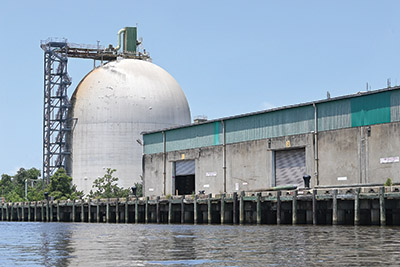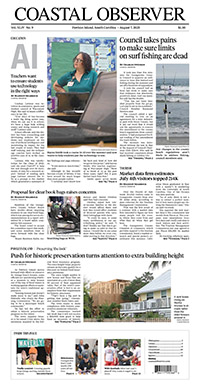Planning
County will cast wide net in port redevelopment

The 40 acres that Georgetown County now owns along the waterfront in Georgetown is only one piece of a larger opportunity for growth, officials say.
Downstream, the county and the city have partnered on a study that could lead to the dredging of the Sampit River that would improve access for recreational boaters and commercial fishing boats.
Upstream, the county is seeking permits to dredge the river to provide barge access to its 948-acre industrial park, which is in the running for a $500 million project from a firm that would employ an estimated 300 people.
“You can’t just look at one part of it,” said Tiffany Harrison, the county’s economic development director. “It all ties together.”
The county took title to the port property last month through a provision in the 2022 state budget that let the State Ports Authority keep money the legislature had previously allocated to dredging the Georgetown harbor.
“We couldn’t just allow it to sit there,” state Rep. Lee Hewitt said of the port property. He first began work on the transfer in 2021.
At the heart of the property is Terminal 31, a 500-foot-long dock and warehouse that was completed in 1959 at a cost of $1.5 million. The first ship to dock was the 7,600-ton Manchester Regiment, which arrived at 3:35 a.m. on Dec. 5.
A register of port traffic from 1959 through the last vessel in 2016 was turned over to the county by the ports authority. County Council Member Bob Anderson, who first spotted the book on a port tour, turned it over to the S.C. Maritime Museum during a program this week that gave local officials a look at the property and the county’s plans.
“I’ve been waiting eight years for this day,” Anderson said.
He traced the takeover to a proposal in 2011 by then-state Sen. Yancey McGill to dredge the harbor and the shipping
channel through Winyah Bay to its approved depth of 27 feet as a way to revitalize the port. That led to a capital projects sales tax approved by county voters in 2014 that provided $6 million toward the estimated $33 million cost of the dredging. That estimate was later revised by the Army Corps of Engineers to $66 million, and the project was scrapped.
“The $6 million is still available. I hope we’ll be able to take care of a lot of problems with the port with that money,” Anderson said.
A survey commissioned by the county found $13.6 million worth of “deficiencies” at the various facilities on the property. Some of the buildings are still in use, such as the main warehouse that now holds rolls of paper from the nearby IP mill and a cement dome that transfers bulk cargo that arrives by rail to tractor-trailer trucks. How and when those leases will be phased out is yet to be decided, Harrison said.
The county has entered into an agreement with the state Department of Health and Environmental Control to identify contaminants on the property and remove them. The “voluntary cleanup contract” allows the county to conduct the work without assuming liability for contaminants left by previous port users. The initial survey identified various storage tanks on the site as well as a refuse burner that was used in the 1920s that may have burned railroad cross-ties treated with creosote.
The county will seek grants for the cleanup.
“The environmental work will tell us what we can and cannot do with the property,” Harrison said.
But she said it will also be influenced by what goes on elsewhere in the harbor.
The Sampit River winds past the port property and the Liberty Steel mill before turning toward the city’s Front Street. On the opposite shore is Goat Island, which is about 20 acres of marsh and uplands that were donated to the city in 2016.
When the city took ownership, it agreed to spend $1.5 million on improvements within five years. It got an extension due to the pandemic, but last week City Council approved a new agreement with the heirs of the original donors to remove the restriction.
“If you could imagine a mirror image of Front Street on Goat Island,” Council Member Jim Clements said. “This is a huge, huge opportunity.”
The council also approved initiating the process to take ownership of two streets that dead end at the river from the state Department of Transportation. One of those, Cannon Street, is the site of a proposed redevelopment that called for the section leading to the water to become a private drive. That project has yet to come before the city Planning Commission.
Council Member Jonathan Angner said the city continues to hear about the need for more water access and it couldn’t risk someone asking DOT to close the street-ends.
“If we let that happen, how can you allow our stakeholders in the city to have access if at some point we do have funds to put public dockage out there?” he said.
Mayor Carol Jayroe agreed.
“We are a waterfront city with no docks to speak of. We have to protect our waterfront,” she said.
During one recent weekend, boats were rafted up three deep at the public docks at the end of Broad and Screven streets.
Last year, the city attempted to revoke the zoning that allows Liberty Steel to continue to operate in a “redevelopment district” along the waterfront that was adopted in 2017. It argued that the mill had closed for more than 365 consecutive days. The city Board of Zoning Appeals reversed that decision.
But the study by the Urban Land Institute that led to the creation of the redevelopment district will also figure into Georgetown County’s plans for the port, Harrison said, even if the mill continues to operate. The county also plans to bring in outside firms to help.
Harrison is due to step down as the county development director to start a consulting firm. But she will remain in the area and has agreed to help the county with the Pennyroyal site and the port redevelopment.
“This will be a comprehensive and inclusive process,” she said. “This is not a quick process. The property will not be redeveloped in six months.”




